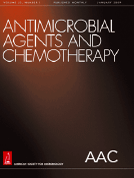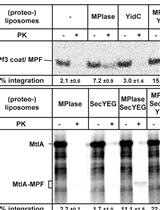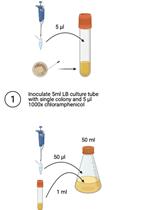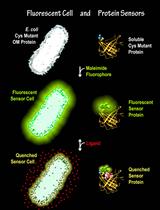- EN - English
- CN - 中文
Characterizing the Transcriptional Effects of Endolysin Treatment on Established Biofilms of Staphylococcus aureus
鉴定内溶素处理对已建立的金黄色葡萄球菌生物膜转录的影响
发布: 2018年06月20日第8卷第12期 DOI: 10.21769/BioProtoc.2891 浏览次数: 5849
评审: Modesto Redrejo-RodriguezBenoit ChassaingAnonymous reviewer(s)
Abstract
Biofilms are the most common lifestyle of bacteria in both natural and human environments. The organized structure of these multicellular communities generally protects bacterial cells from external challenges, thereby enhancing their ability to survive treatment with antibiotics or disinfectants. For this reason, the search for new antibiofilm strategies is an active field of study. In this context, bacteriophages (viruses that infect bacteria) and their derived proteins have been proposed as promising alternatives for eliminating biofilms. For instance, endolysins can degrade peptidoglycan and, ultimately, lyse the target bacterial cells. However, it is important to characterize the responses of bacterial cells exposed to these compounds in order to improve the design of phage-based antimicrobial strategies.
This protocol was developed to examine the transcriptional responses of Staphylococcus aureus biofilm cells exposed to endolysin treatment, as previously described in Fernández et al. (2017). However, it may be subsequently adapted to analyze the response of other microorganisms to different antimicrobials.
Background
It is becoming increasingly clear that subinhibitory doses of antimicrobials may have a regulatory effect on different phenotypes of the target microbes, including biofilm formation, metabolism or virulence. Therefore, studying the potential impact of a novel compound on the target cells at low-level concentrations should be a part of the development process. Indeed, a very effective antibacterial agent that triggers production of virulence factors or antibiotic resistance determinants may not be a good candidate for therapeutic application. On the other hand, considering the physiological differences between biofilm and planktonic cells, it seems logical that the effect of new antibiofilm agents should be analyzed on biofilm-forming cells. Here, we describe a protocol for the analysis of transcriptional responses of biofilm cells upon exposure to subinhibitory concentrations of endolysins, phage-derived proteins that show great promise as biofilm removal agents. Thus, the transcriptome of endolysin-treated cells was compared to control cells by RNA-seq and differential expression of selected genes was later confirmed by RT-qPCR.
Materials and Reagents
- Standard Petri dishes (Labbox, catalog number: PDIP-09N-500 )
- Sterile 10 ml polystyrene culture tubes (Deltalab, catalog number: 300903 )
- Cuvettes for OD600 reading (Deltalab, catalog number: 303103 )
- 1.5 ml microcentrifuge tubes (SARSTEDT, catalog number: 72.690.001 )
- 12-well microtiter plates with Nunclon Delta surface (Thermo Fisher Scientific, Nunc, catalog number: 150628 )
- Sterile plastic loops (1 μl) (VWR, catalog number: 612-9351 )
- MicroAmp® Fast optical 96-well reaction plate with barcode (Thermo Fisher Scientific, Applied Biosystems, catalog number: 4346906 )
- MicroAmp® optical adhesive film (Thermo Fisher Scientific, Applied Biosystems, catalog number: 4311971 )
- Frozen stock of Staphylococcus aureus (for example, S. aureus IPLA1 from our laboratory collection) stored in glycerol at -80 °C
- Filtered LysH5 endolysin stock stored in NaPi buffer with 30% glycerol at -80 °C (~350 μg/ml = 5.8 μM) purified as described previously (Gutiérrez et al., 2014)
- Agarose for electrophoresis (Conda, catalog number: 8008 )
- Glass beads, acid washed (≤ 106 µm, sterile) (Sigma-Aldrich, catalog number: G4649 )
- RNA protect® Bacteria Reagent (QIAGEN, catalog number: 76560 )
- IllustraTM RNAspin Mini Kit (GE Healthcare, catalog number: 25050071 )
- Chloroform (Merck, catalog number: 1024451000 )
- Ethanol (Fisher Scientific, catalog number: BP28184 )
- SUPERase-InTM RNase Inhibitor (Thermo Fisher Scientific, InvitrogenTM, catalog number: AM2694 )
- Turbo DNA-free kitTM (Thermo Fisher Scientific, InvitrogenTM, catalog number: AM1907 )
- DL-Dithiothreitol (Sigma-Aldrich, catalog number: D0632-5G )
- Phenol, Molecular Biology Grade (Merck, Calbiochem, catalog number: 516724-100GM )
- iScriptTM Reverse Transcription Supermix for RT-qPCR (Bio-Rad Laboratories, catalog number: 1708841 )
- Power SYBR® Green PCR Master Mix (Thermo Fisher Scientific, Applied BiosystemsTM, catalog number: 4367659 )
- Bacteriological agar (ROKO S.A.)
- D(+)-Glucose (Merck, catalog number: 1.08337.1000 )
- Sodium chloride (NaCl) (Merck, catalog number: 1.06404.1000 )
- Potassium chloride (KCl) (VWR, BDH, catalog number: 437025H )
- Sodium phosphate dibasic (Na2HPO4) (VWR, AnalaR NORMAPUR, catalog number: 102495D )
- Potassium phosphate monobasic (KH2PO4) (Merck, catalog number: 1048731000 )
- Sodium dihydrogen phosphate monohydrate (NaH2PO4·H2O) (ITW Reagents Division, AppliChem, catalog number: 131965.1211 )
- UltraPureTM Tris Buffer (Thermo Fisher Scientific, catalog number: 15504020 )
- Glacial acetic acid (Merck, catalog number: 1.00063.2500 )
- 0.5 M EDTA (pH 8.0) (Alfa Aesar, USB, catalog number: J15701 )
- TSB medium (tryptic soy broth, Scharlab, catalog number: 02-200-500 ) (see Recipes)
- TSA agar plates (see Recipes)
- TSB medium supplemented with glucose (TSBG) (see Recipes)
- Phosphate buffered saline (PBS) solution (see Recipes)
- Sodium phosphate (NaPi) buffer (see Recipes)
- Tris-acetate-EDTA (TAE) buffer (see Recipes)
Equipment
- Pipettes (volume ranges: 1 μl-10 μl, 2 μl-20 μl, 20 μl-200 μl, 200 μl-1,000 μl)
- Shaking (250 rpm) and static incubators at 25 °C and 37 °C
- Spectrophotometer
Note: It is used to measure optical density (OD600) of cell culture. - Epoch microplate spectrophotometer (BioTek Instruments, model: Epoch )
- Refrigerated centrifuge (Eppendorf, model: 5415 R )
- FastPrep®-24 (MP Biomedicals, catalog number: 116004500 )
- Gel electrophoresis apparatus (Bio-Rad Laboratories, Mini-Sub® Cell GT Cell)
- Vortex
- 7500 Fast Real-Time PCR System (Thermo Fisher Scientific, Applied Biosystems, catalog number: 4351107 )
- Illumina HiSeq2000 platform
- Computer equipped with four Intel Xeon E5-4650 v2 2.4GHz 25M 8GT/s 10-core processors, 256 GB RAM, and running CentOS Linux release 7.3.1611
Note: The computer is for carrying out computation.
Software
- FastQC (http://www.bioinformatics.babraham.ac.uk/projects/download.html#fastqc)
- BowTie2 (http://bowtie-bio.sourceforge.net/bowtie2/index.shtml) (Langmead and Salzberg, 2012)
- EDGE-Pro (http://ccb.jhu.edu/software/EDGE-pro/) (Magoc et al., 2013)
- DEseq2 (http://bioconductor.org/packages/release/bioc/html/DESeq2.html) (Love et al., 2014)
Procedure
文章信息
版权信息
© 2018 The Authors; exclusive licensee Bio-protocol LLC.
如何引用
Fernández, L., González, S., Gutiérrez, D., Campelo, A. B., Martínez, B., Rodríguez, A. and García, P. (2018). Characterizing the Transcriptional Effects of Endolysin Treatment on Established Biofilms of Staphylococcus aureus. Bio-protocol 8(12): e2891. DOI: 10.21769/BioProtoc.2891.
分类
微生物学 > 微生物生物膜 > 对抗菌剂的反应
分子生物学 > 蛋白质 > 活性
分子生物学 > RNA > RNA 测序
您对这篇实验方法有问题吗?
在此处发布您的问题,我们将邀请本文作者来回答。同时,我们会将您的问题发布到Bio-protocol Exchange,以便寻求社区成员的帮助。
提问指南
+ 问题描述
写下详细的问题描述,包括所有有助于他人回答您问题的信息(例如实验过程、条件和相关图像等)。
Share
Bluesky
X
Copy link












